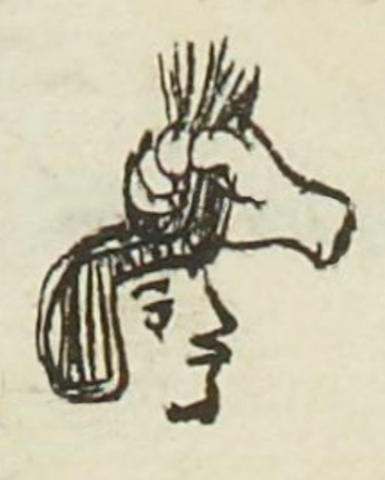Matelchiuh (MH518r)
This black-line drawing of the simplex glyph for the personal name Matelchiuh shows a man's head in profile looking toward the viewer's right. The (right) hand (maitl)] of another person is grabbing a large portion of hair on the first person's hair.
Stephanie Wood
The phonetic "ma" from hand provides the start to this name, but the rest of it (telchihua, telchiuh) is inferred by the action of dishonoring someone. As López Austin has explained (The Human Body and Ideology, 19898, v. 1, 220), the tonalli (sacred force) of a person was connected to the head and the hair, and thus was not to be mishandled by another person. Hair was rarely washed or cut, because it protected the tonalli. To forcibly cut someone's hair was extremely deprecating. War captives were grabbed by the hair, which disgraced them. [For a long discussion about Nahuas and hair, see Sonya Lipsett-Rivera, "Language of the Body and the Body as Language," in Religion in New Spain, ed. Susan Schroeder and Stafford Poole, 2007, 72.]
peo matelchiuh
Pedro Matelchiuh
Stephanie Wood
1560
Jeff Haskett-Wood
nombres de hombres

matel, an optative indicator, https://nahuatl.wired-humanities.org/content/matel
chihua, to do, https://nahuatl.wired-humanities.org/content/chihua
telchihua, to deprecate someone, https://nahuatl.wired-humanities.org/content/telchihua
Matrícula de Huexotzinco, folio 518r, World Digital Library, https://www.loc.gov/resource/gdcwdl.wdl_15282/?sp=115&st=image
This manuscript is hosted by the Library of Congress and the World Digital Library; used here with the Creative Commons, “Attribution-NonCommercial-ShareAlike 3.0 License” (CC-BY-NC-SAq 3.0).


